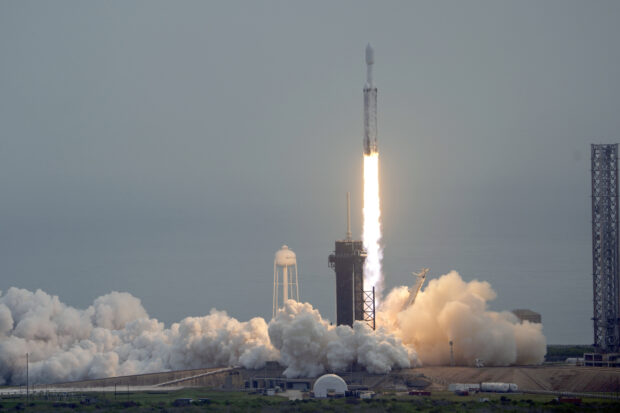A SpaceX Falcon Heavy rocket lifts off from Launch Pad 39A at the Kennedy Space Center in Cape Canaveral, Florida, on Friday, October 13, 2023. This mission will take the spacecraft to the metallic asteroid Psyche, where it will enter orbit in 2029, marking the first-ever exploration of a metal-rich asteroid. (AP Photo/John Raoux)
In a historic event, NASA’s Psyche spacecraft launched on Friday, embarking on a six-year journey to a rare asteroid covered in metal. Unlike most asteroids, which are predominantly rocky or icy, this mission will explore a metal world. Scientists speculate that the asteroid, named Psyche after the Greek goddess of the soul, may be the remnants of a planetary core, offering valuable insights into the inaccessible centers of Earth and other rocky planets. The spacecraft, launched by SpaceX from NASA’s Kennedy Space Center, is set to reach its target, a large potato-shaped object, in 2029. The excitement surrounding this mission is palpable, with scientists and researchers eagerly anticipating what they hope to discover.
An hour after launch, the spacecraft successfully separated from the rocket’s upper stage and floated away, prompting cheers from ground controllers. For decades, NASA has been exploring distant worlds composed of rock, ice, and gas. Now, with Psyche, they have the opportunity to study an asteroid coated in metal. Psyche is the largest known metal-rich asteroid, orbiting the sun in the outer region of the main asteroid belt between Mars and Jupiter. Discovered in 1852, it now offers scientists a chance to unlock the mysteries of a world made of metal.
What lies ahead is both awe-inspiring and challenging. Astronomers have estimated that the asteroid is approximately 144 miles (232 kilometers) wide at its widest point and 173 miles (280 kilometers) long. It is believed to be rich in iron, nickel, and other metals, possibly accompanied by silicates. The surface is likely a dull gray, covered in fine metal grains from cosmic impacts. But that’s just the beginning. Scientists envision a landscape filled with spiky metal craters, towering metal cliffs, and lava flows encased in metal. Notably, this is just speculation, and the reality may exceed our wildest imaginations. Trace amounts of precious metals like gold, silver, platinum, or iridium could potentially be present within the asteroid’s iron and nickel composition.
Aside from its intriguing composition, the Psyche asteroid serves as an essential piece of the puzzle when it comes to understanding the formation of our solar system. Believed to be a building block dating back 4.5 billion years, this celestial body can shed light on fundamental questions about the origins of life on Earth and what makes our planet habitable. The iron core of our planet generates a magnetic field that protects our atmosphere and enables life as we know it. By studying the Psyche asteroid, scientists hope to gain valuable insights into these crucial processes.
The mission, led by Arizona State University on behalf of NASA, comes with a price tag of $1.2 billion. To reach the asteroid, the spacecraft will take a circuitous route. After launch, it will utilize Mars’ gravity for a boost in 2026. Three years later, it will finally arrive at Psyche and attempt to enter orbit around the asteroid. It will circle the asteroid at varying distances, ranging from 47 miles (75 kilometers) to as high as 440 miles (700 kilometers), until at least 2031. The spacecraft will rely on solar electric propulsion, using xenon gas-fed thrusters to propel itself. Additionally, an experimental communication system utilizing lasers will be tested to enhance data transmission from deep space to Earth. If successful, this technology could pave the way for future missions to transmit videos from the moon or Mars.
Originally scheduled to launch earlier, the Psyche mission experienced delays due to issues related to flight software testing and management. Consequently, the mission timeline had to be readjusted, pushing back the arrival at the asteroid from 2026 to 2029. Coincidentally, this is the same year when another NASA spacecraft, returning from collecting asteroid samples, is expected to reach a different space rock near Earth. As the countdown begins, the anticipation and excitement surrounding the Psyche mission continue to grow, with the potential for groundbreaking discoveries and revelations.
Your subscription could not be saved. Please try again.
Your subscription has been successful.
Denial of responsibility! Vigour Times is an automatic aggregator of Global media. In each content, the hyperlink to the primary source is specified. All trademarks belong to their rightful owners, and all materials to their authors. For any complaint, please reach us at – [email protected]. We will take necessary action within 24 hours.


